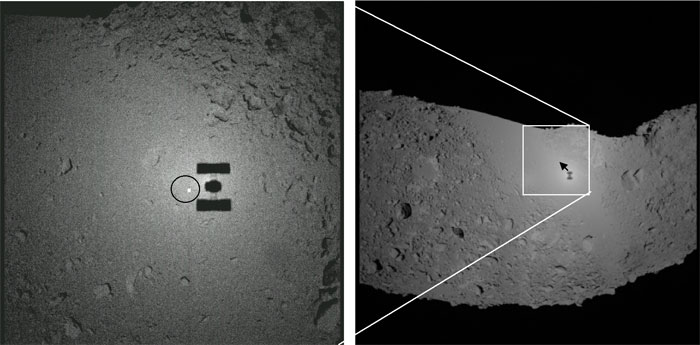Japanese Probe Aims for Second Landing on Asteroid

Japan's Hayabusa spacecraft has begun a descent toward asteroid Itokawa for a second landing attempt.
Scientists, spacecraft engineers and ground controllers are hopeful of achieving a mission goal of snagging samples of the space rock for return to Earth.
Hayabusa is en route to Itokawa, descending smoothly at roughly two inches (six centimeters) per second. If all goes as planned, the craft would make contact with the asteroid early Saturday, Japan Standard Time.
The first soft landing of the multi-tasked Hayabusa spacecraft atop Itokawa took place on November 20-21 - a milestone that was eventually confirmed, but only after careful scrutiny of spacecraft data.
The mission is being run by Japan's space agency, JAXA, and its space research arm, the Institute of Space and Astronautical Science (ISAS).
First landing and takeoff
According to JAXA/ISAS engineers, last weekend's touchdown involved Hayabusa's sampling equipment -- mounted on the bottom of the craft -- and possibly a tip end of a solar panel making contact with the asteroid. A
mission website proudly declares that Hayabusa became the world's first spacecraft to take off from an asteroid, and a first-time departure from a celestial body, except for the Moon.
Get the Space.com Newsletter
Breaking space news, the latest updates on rocket launches, skywatching events and more!
During that first landing run, a marker carrying signatures from individuals around the world was released by Hayabusa. It likely landed in a southwest spot of an area labeled Muses Sea on asteroid Itokawa.
"It was a good surprise that the on-board data show that Hayabusa did make contact with Itokawa, stay over there for a while, and lift off successfully," said Kazuya Yoshida, director of the aerospace engineering department at Tohoku University.
Yoshida is also a member of the Space Robotics Laboratory team at the university that took part in Hayabusa's design and development.
Mysterious sequence of events
At first, JAXA spokespersons said that the craft did not make the asteroid touchdown.
Yoshida told SPACE.com that he was convinced that the probe did make contract with Itokowa. He said that the "somewhat mysterious sequence of events" on Hayabusa would not have occurred without any physical contact with the object.
"An unfortunate thing was that a sensor detected an obstacle, or something, at an unexpected timing," Yoshida said. That event happened during the craft's autonomous surface alignment and final free-fall sequence onto Itokawa.
Subsequently, contact detection and the initiation of Hayabusa's sampling mode did not activate," Yoshida added.
Samples already onboard?
Touching down on Itokawa is an incredible triumph, said Andrew Cheng, a member of the Hayabusa science team at Johns Hopkins Applied Physics Laboratory (APL) in Laurel, Maryland.
"The spacecraft actually bounced off the surface a few times and spent about 39 minutes resting on the asteroid, but apparently the samplers never fired," Cheng told SPACE.com. He said that it's possible some material from the asteroid may have made its way into the spacecraft's collection chamber.
"After all the thrashing about...there is no way to confirm that," Cheng said.
Tough assignment
Cheng is no stranger to cruising about and landing upon an asteroid. He was project scientist for NASA's Near Earth Asteroid Rendezvous (NEAR) - Shoemaker spacecraft that orbited asteroid Eros for a year, then gently touched down on the object on February 12, 2001.
However, NEAR was not designed as a landing or sampling probe.
"Somehow this doesn't feel the same to me as the NEAR landing," Cheng said. "On NEAR we had already accomplished all our prime mission objectives, and the landing was a bonus. But we don't know if Hayabusa has acquired samples, and we are waiting to see if it can come back with the goods," he noted.
Cheng said that he does feel that reaching the surface is a remarkable accomplishment for Hayabusa, especially considering a series of hardware problems that the probe's flight controllers have had to overcome.
"The little asteroid Itokawa is a wild place, incredibly so, whereas Eros is much more benign in terms of its accommodations for landing. Sampling Itokawa is a tough assignment, no question," Cheng concluded.
Join our Space Forums to keep talking space on the latest missions, night sky and more! And if you have a news tip, correction or comment, let us know at: community@space.com.

Leonard David is an award-winning space journalist who has been reporting on space activities for more than 50 years. Currently writing as Space.com's Space Insider Columnist among his other projects, Leonard has authored numerous books on space exploration, Mars missions and more, with his latest being "Moon Rush: The New Space Race" published in 2019 by National Geographic. He also wrote "Mars: Our Future on the Red Planet" released in 2016 by National Geographic. Leonard has served as a correspondent for SpaceNews, Scientific American and Aerospace America for the AIAA. He has received many awards, including the first Ordway Award for Sustained Excellence in Spaceflight History in 2015 at the AAS Wernher von Braun Memorial Symposium. You can find out Leonard's latest project at his website and on Twitter.









